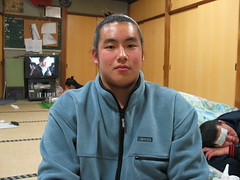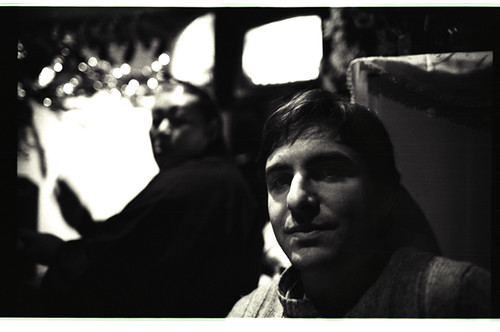Stablemates II
KAZUYA

When I dropped in on the Oyakata the other day, he told me that convincing potential wrestlers to join his stable was seldom an easy task. "You keep talking to them, not just once or twice, but over and over," he said. "It can take a year or two until they come around."
That seemed to have been the case with Kazuya. He first met the Oyakata when he graduated from junior high school, where he was a devoted badminton player. He accepted the Oyakata's invitation to drop by the stable for a couple nights, but wasn't convinced. He'd been offered a spot on the varsity badminton team at the high school he planned to attend and was eager to accept it. (That's right, I said "Varsity badminton." Don't laugh: it's an Olympic sport at which Japan's East Asian neighbors have excelled.)
He started high school. Like most of the school's athletes, he lived in its dormitory, so he'd be closer to his teammates and have more time to practice with them and work out on his own. But the Oyakata was persistent. He implored Kazuya to come by the stable one more time, which he did last winter during his New Year's vacation. And this time, while watching the wrestlers train in the morning, he decided to change course.
"When I was a kid, I thought sumo was cool," he said. "Then, when I came here and saw it, I started thinking, 'Wow, this really is cool.' It's not like pro-wrestling; it's real, authentic fighting. " With the blessing of his father, a mason, and his mother, he left his hometown of Fukuoka on the southern island of Japan's main archipelago, also leaving behind an older sister who worked as a bar hostess and a younger brother who was still in school.
Sumo life wasn't that difficult an adjustment for Kazuya. As a high school athlete, he was also up early each morning, conditioning his body, he said. And in high school, he ran errands and did laundry for his two senpai—one from each grade above his—so not even being the Sekitori's tsukebito, as he now was, was all that new.
He likes the camaraderie that sumo life offers, he said. He enjoys living with a group of people all working toward the same goal. But he does wish he had more time for himself. "I don't have time for fun," he said. "I don't have time for a girlfriend."
In addition to his training regimen and work responsibilities as a rookie wrestler and tsukebito to the Sekitori, he's finishing high school through a correspondence course. Without a high school degree, he said, he knows he'll have trouble finding work once he leaves sumo. He hopes to be a gym teacher when he retires from the sport.
NEXT: The Bon-En-Kai

When I dropped in on the Oyakata the other day, he told me that convincing potential wrestlers to join his stable was seldom an easy task. "You keep talking to them, not just once or twice, but over and over," he said. "It can take a year or two until they come around."
That seemed to have been the case with Kazuya. He first met the Oyakata when he graduated from junior high school, where he was a devoted badminton player. He accepted the Oyakata's invitation to drop by the stable for a couple nights, but wasn't convinced. He'd been offered a spot on the varsity badminton team at the high school he planned to attend and was eager to accept it. (That's right, I said "Varsity badminton." Don't laugh: it's an Olympic sport at which Japan's East Asian neighbors have excelled.)
He started high school. Like most of the school's athletes, he lived in its dormitory, so he'd be closer to his teammates and have more time to practice with them and work out on his own. But the Oyakata was persistent. He implored Kazuya to come by the stable one more time, which he did last winter during his New Year's vacation. And this time, while watching the wrestlers train in the morning, he decided to change course.
"When I was a kid, I thought sumo was cool," he said. "Then, when I came here and saw it, I started thinking, 'Wow, this really is cool.' It's not like pro-wrestling; it's real, authentic fighting. " With the blessing of his father, a mason, and his mother, he left his hometown of Fukuoka on the southern island of Japan's main archipelago, also leaving behind an older sister who worked as a bar hostess and a younger brother who was still in school.
Sumo life wasn't that difficult an adjustment for Kazuya. As a high school athlete, he was also up early each morning, conditioning his body, he said. And in high school, he ran errands and did laundry for his two senpai—one from each grade above his—so not even being the Sekitori's tsukebito, as he now was, was all that new.
He likes the camaraderie that sumo life offers, he said. He enjoys living with a group of people all working toward the same goal. But he does wish he had more time for himself. "I don't have time for fun," he said. "I don't have time for a girlfriend."
In addition to his training regimen and work responsibilities as a rookie wrestler and tsukebito to the Sekitori, he's finishing high school through a correspondence course. Without a high school degree, he said, he knows he'll have trouble finding work once he leaves sumo. He hopes to be a gym teacher when he retires from the sport.
NEXT: The Bon-En-Kai



<< Home